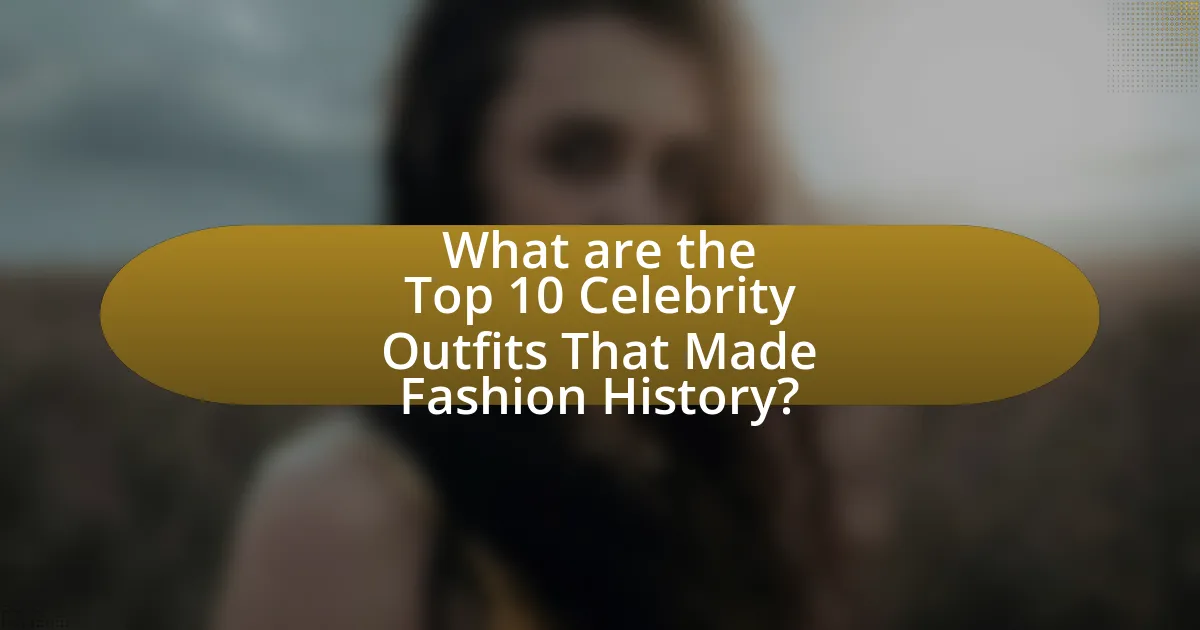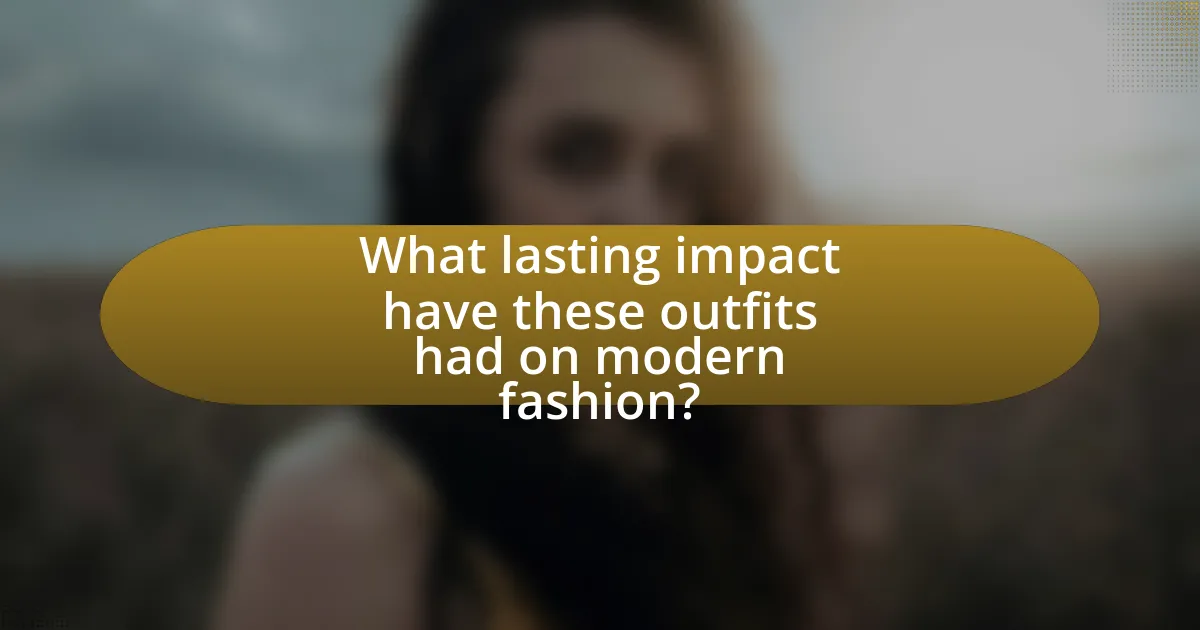The article focuses on the “Top 10 Celebrity Outfits That Made Fashion History,” highlighting iconic ensembles that have significantly influenced the fashion industry and cultural conversations. Key outfits include Marilyn Monroe’s white dress from “The Seven Year Itch,” Audrey Hepburn’s black dress in “Breakfast at Tiffany’s,” and Beyoncé’s gold gown at the 2015 Met Gala. The article examines how these outfits set trends, challenged traditional fashion norms, and reflected societal shifts, while also discussing the celebrities behind these historic looks and the lasting impact they have had on modern fashion. Additionally, it explores the design elements, cultural significance, and the lessons individuals can learn from these iconic styles.

What are the Top 10 Celebrity Outfits That Made Fashion History?
The Top 10 Celebrity Outfits That Made Fashion History include:
- Marilyn Monroe’s white dress from “The Seven Year Itch” (1955) – This iconic outfit became a symbol of femininity and glamour.
- Audrey Hepburn’s black dress in “Breakfast at Tiffany’s” (1961) – This outfit redefined elegance and is still referenced in modern fashion.
- Princess Diana’s “revenge dress” (1994) – Worn after her separation from Prince Charles, it showcased empowerment and boldness.
- Beyoncé’s gold gown at the 2015 Met Gala – This outfit celebrated the theme of “China: Through the Looking Glass” and highlighted her status as a fashion icon.
- Lady Gaga’s meat dress at the 2010 MTV Video Music Awards – This controversial outfit sparked discussions about fashion and activism.
- Rihanna’s yellow Guo Pei gown at the 2015 Met Gala – This outfit was a statement piece that showcased cultural appreciation and artistry.
- Cher’s Bob Mackie-designed outfit at the 1986 Oscars – This ensemble was groundbreaking for its boldness and theatricality.
- Kate Middleton’s wedding dress by Alexander McQueen (2011) – This gown became a modern classic and influenced bridal fashion worldwide.
- Janelle Monáe’s black and white tuxedo – This outfit challenged gender norms and became a symbol of androgynous fashion.
- Zendaya’s 2015 Oscars dress – This outfit made headlines for its cultural significance and sparked conversations about race and beauty standards.
These outfits not only defined moments in fashion history but also influenced cultural conversations and trends.
How did these outfits influence the fashion industry?
These outfits significantly influenced the fashion industry by setting new trends and redefining style norms. For instance, iconic ensembles worn by celebrities such as Audrey Hepburn in “Breakfast at Tiffany’s” popularized the little black dress, establishing it as a timeless wardrobe staple. Similarly, Lady Gaga’s avant-garde fashion choices challenged conventional aesthetics and encouraged designers to experiment with bold, unconventional materials and silhouettes. The impact of these outfits is evident in the way they inspired subsequent collections from major fashion houses, leading to a shift in consumer preferences towards more daring and expressive styles.
What trends emerged from these iconic outfits?
Trends that emerged from these iconic outfits include the rise of bold colors, innovative silhouettes, and the blending of high fashion with streetwear. For instance, the use of vibrant hues became prominent after celebrities like Rihanna and Lady Gaga showcased striking outfits that challenged traditional color palettes. Additionally, the introduction of unconventional shapes and structures, as seen in outfits worn by figures such as Beyoncé, pushed the boundaries of design, influencing designers to experiment with form. The fusion of luxury fashion with casual elements, exemplified by stars like Kanye West, has also reshaped contemporary style, leading to a more relaxed yet chic aesthetic in mainstream fashion. These trends reflect a shift towards individuality and self-expression in fashion, driven by the influence of celebrity culture.
How did these outfits reflect cultural shifts?
These outfits reflected cultural shifts by embodying the changing values and social norms of their respective eras. For instance, the introduction of punk fashion in the 1970s, exemplified by Vivienne Westwood’s designs, challenged traditional aesthetics and promoted individualism and rebellion against the establishment. Similarly, the rise of athleisure in the 2010s, popularized by celebrities like Beyoncé, mirrored a growing emphasis on health, wellness, and casual lifestyles, indicating a shift towards comfort and functionality in fashion. These examples illustrate how specific outfits not only influenced trends but also served as visual representations of broader societal changes, such as the embrace of diversity, self-expression, and the blending of formal and informal styles.
Who are the celebrities behind these historic outfits?
The celebrities behind these historic outfits include Audrey Hepburn, who wore the iconic black dress in “Breakfast at Tiffany’s,” and Lady Gaga, known for her meat dress at the 2010 MTV Video Music Awards. Additionally, Marilyn Monroe is famous for the white dress she wore in “The Seven Year Itch,” while Beyoncé made headlines in her stunning yellow gown at the 2015 Met Gala. Each of these outfits has left a significant mark on fashion history, showcasing the influence of these celebrities in shaping trends and cultural moments.
What is the background of each celebrity’s fashion choices?
The background of each celebrity’s fashion choices is influenced by their personal experiences, cultural contexts, and the fashion industry trends at the time. For instance, Rihanna’s fashion choices often reflect her Caribbean heritage and her desire to challenge traditional gender norms, as seen in her bold and eclectic styles. Similarly, Lady Gaga’s outfits frequently draw from avant-garde art and performance, showcasing her commitment to self-expression and pushing boundaries in fashion. Additionally, Audrey Hepburn’s classic elegance in films like “Breakfast at Tiffany’s” has left a lasting impact on fashion, embodying the timeless appeal of simplicity and sophistication. Each celebrity’s unique background and the societal influences they navigate shape their distinctive fashion identities.
How did their personal style contribute to the outfit’s impact?
Their personal style significantly enhanced the outfit’s impact by reflecting individuality and setting trends. For instance, a celebrity known for bold colors and unique patterns can transform a simple ensemble into a statement piece, influencing public perception and fashion choices. This is evident in how certain celebrities have popularized specific styles, such as the oversized blazer trend initiated by influential figures, which led to widespread adoption in mainstream fashion. The combination of personal flair and cultural relevance creates a lasting impression, making the outfit not just clothing but a symbol of style evolution.
What events or occasions featured these outfits?
The outfits featured in “Top 10 Celebrity Outfits That Made Fashion History” were showcased at significant events such as the Academy Awards, Met Gala, and various film premieres. For instance, Audrey Hepburn’s iconic black dress from “Breakfast at Tiffany’s” was worn during the film’s premiere in 1961, while Lady Gaga’s meat dress was famously displayed at the 2010 MTV Video Music Awards. These occasions are pivotal in the fashion industry, often setting trends and influencing public perception of style.
How did the context of each event enhance the outfit’s significance?
The context of each event enhanced the outfit’s significance by aligning the clothing choices with pivotal cultural moments, thereby amplifying their impact. For instance, when a celebrity wore a groundbreaking outfit at a major awards ceremony, it often reflected societal shifts, such as movements for equality or changes in fashion norms. This alignment not only drew public attention but also sparked conversations around the themes represented by the outfit, such as empowerment or rebellion. Historical examples include the iconic black dress worn by Audrey Hepburn in “Breakfast at Tiffany’s,” which became a symbol of elegance and sophistication during a time of post-war fashion revival. Such contexts provide a deeper understanding of why these outfits are remembered, as they resonate with the emotions and values of the era in which they were worn.
What reactions did these outfits receive at the time?
The outfits received a mix of admiration and criticism at the time, reflecting their impact on fashion trends. For instance, when Jennifer Lopez wore the iconic green Versace dress to the 2000 Grammy Awards, it sparked widespread media attention and became a defining moment in red carpet history, leading to a surge in searches for similar styles. Similarly, Lady Gaga’s meat dress at the 2010 MTV Video Music Awards elicited shock and debate, with some praising its bold statement on fashion and others condemning it as distasteful. These reactions illustrate how these outfits not only influenced public perception but also shaped future fashion choices and discussions.
![]()
What are the key characteristics of these iconic outfits?
The key characteristics of these iconic outfits include bold designs, innovative materials, and cultural significance. Each outfit often features unique silhouettes that challenge traditional fashion norms, such as the structured corsets of the 1950s or the oversized shapes of the 1980s. Additionally, many of these outfits utilize groundbreaking fabrics or techniques, like the use of sustainable materials or advanced tailoring methods, which set trends in the fashion industry. Furthermore, these outfits frequently reflect the social and political climates of their times, making them not just fashion statements but also symbols of cultural movements, such as the punk rock aesthetic of the 1970s or the glamorous styles of Hollywood’s Golden Age.
What design elements made these outfits stand out?
The design elements that made these outfits stand out include bold colors, unique silhouettes, intricate detailing, and innovative materials. For instance, the use of vibrant hues captures attention and conveys personality, while distinctive shapes can redefine body lines and create visual interest. Additionally, intricate embellishments such as sequins or embroidery enhance the overall aesthetic, adding depth and texture. Innovative materials, like sustainable fabrics or high-tech textiles, not only elevate the design but also reflect contemporary values in fashion. These elements collectively contribute to the memorability and impact of the outfits in fashion history.
How did color and fabric choices contribute to their legacy?
Color and fabric choices significantly contributed to the legacy of iconic celebrity outfits by establishing visual identities and cultural statements. For instance, the use of bold colors like red in outfits worn by celebrities such as Marilyn Monroe and Rihanna not only drew attention but also symbolized confidence and empowerment, influencing fashion trends and societal perceptions. Additionally, the selection of luxurious fabrics, such as silk and velvet, in outfits worn by figures like Audrey Hepburn and Beyoncé elevated their status and showcased craftsmanship, reinforcing their influence in the fashion industry. These choices have left a lasting impact, as they continue to inspire designers and shape contemporary fashion narratives.
What accessories complemented these outfits?
The accessories that complemented these outfits included statement jewelry, designer handbags, and stylish footwear. For instance, iconic outfits often featured bold necklaces or earrings that drew attention and enhanced the overall look. Additionally, high-end handbags from luxury brands served as both functional and fashionable elements, while unique shoes, such as stilettos or custom sneakers, completed the ensembles, showcasing the celebrities’ personal styles and setting trends in the fashion industry.
How did these outfits challenge traditional fashion norms?
These outfits challenged traditional fashion norms by introducing unconventional silhouettes, bold color palettes, and gender-fluid designs. For instance, the iconic black dress worn by Audrey Hepburn in “Breakfast at Tiffany’s” redefined elegance by emphasizing simplicity over extravagance, while David Bowie’s flamboyant costumes blurred gender lines and promoted self-expression. Additionally, Rihanna’s Met Gala gown in 2015, which featured a dramatic train and intricate embroidery, defied conventional beauty standards and showcased the power of avant-garde fashion. These examples illustrate how celebrity outfits not only pushed boundaries but also influenced broader cultural perceptions of style and identity.
What boundaries were pushed by these celebrity choices?
Celebrity choices in fashion have pushed boundaries by challenging traditional gender norms, redefining beauty standards, and promoting body positivity. For instance, celebrities like Billy Porter and Harry Styles have embraced gender-fluid fashion, wearing garments traditionally associated with the opposite sex, which has sparked conversations about masculinity and self-expression. Additionally, figures like Lizzo and Ashley Graham have advocated for inclusivity by showcasing diverse body types on major platforms, thereby shifting societal perceptions of beauty. These choices have not only influenced public opinion but have also led to changes in the fashion industry, encouraging designers to create more inclusive and varied collections.
How did these outfits redefine gender or body image in fashion?
These outfits redefined gender and body image in fashion by challenging traditional norms and promoting inclusivity. For instance, the introduction of androgynous styles by celebrities like David Bowie and Janelle Monáe blurred the lines between masculine and feminine aesthetics, encouraging a broader acceptance of diverse gender expressions. Additionally, body-positive movements, exemplified by figures such as Lizzo and Ashley Graham, showcased outfits that celebrated various body types, thereby shifting the fashion narrative from a narrow ideal to one that embraces all shapes and sizes. This evolution is supported by the rise of brands prioritizing inclusivity, such as Savage X Fenty, which has been recognized for its diverse runway shows and marketing campaigns that reflect a wide range of body images.

What lasting impact have these outfits had on modern fashion?
The outfits worn by celebrities that made fashion history have significantly influenced modern fashion by setting trends that continue to resonate today. For instance, the iconic little black dress popularized by Audrey Hepburn in “Breakfast at Tiffany’s” has become a timeless staple in women’s wardrobes, symbolizing elegance and versatility. Additionally, the bold styles of figures like David Bowie and Madonna have encouraged a culture of self-expression and gender fluidity in fashion, leading to a more inclusive approach in contemporary design. These historical outfits have not only shaped aesthetic preferences but also established cultural movements, as seen in the rise of streetwear inspired by celebrity styles, which now dominates the fashion landscape.
How are these outfits referenced in contemporary fashion today?
Contemporary fashion references iconic celebrity outfits through modern reinterpretations and collaborations that celebrate their historical significance. For example, the influence of Princess Diana’s bold fashion choices is evident in current collections by designers like Versace, who incorporate similar silhouettes and vibrant colors. Additionally, the impact of Beyoncé’s 2018 Met Gala gown, inspired by African culture, has led to a resurgence of cultural motifs in fashion, as seen in collections by brands like Balmain. These references highlight how past celebrity styles continue to shape trends, demonstrating their lasting impact on today’s fashion landscape.
What designers have drawn inspiration from these historic looks?
Designers such as Ralph Lauren, Alexander McQueen, and Jean Paul Gaultier have drawn inspiration from historic celebrity outfits that made fashion history. Ralph Lauren often incorporates vintage Americana styles reminiscent of iconic looks from the past, while Alexander McQueen has famously reinterpreted historical silhouettes and themes in his collections, reflecting a deep appreciation for fashion history. Jean Paul Gaultier has also been known to reference classic styles, blending them with modern elements to create innovative designs. These designers exemplify how historic looks continue to influence contemporary fashion.
How do these outfits influence current celebrity fashion choices?
Outfits that made fashion history significantly influence current celebrity fashion choices by setting trends that are often revisited and reinterpreted. For instance, iconic ensembles worn by celebrities like Audrey Hepburn or Princess Diana have inspired modern designers and celebrities alike, leading to a resurgence of vintage styles in contemporary wardrobes. The impact is evident in fashion shows and red carpet events, where celebrities frequently reference historical outfits, showcasing how past styles can be adapted to fit current aesthetics. This cyclical nature of fashion is supported by the fact that many designers cite historical influences in their collections, demonstrating a clear lineage from past to present in celebrity fashion.
What lessons can we learn from these iconic outfits?
Iconic outfits teach us the importance of self-expression and the impact of fashion on culture. These outfits often reflect societal values and trends of their time, demonstrating how clothing can serve as a powerful form of communication. For instance, Audrey Hepburn’s little black dress in “Breakfast at Tiffany’s” symbolizes timeless elegance and has influenced countless designs since its debut in 1961. Additionally, Lady Gaga’s meat dress at the 2010 MTV Video Music Awards sparked discussions about fashion as a statement on social issues, showcasing how bold choices can provoke thought and conversation. Such examples illustrate that fashion is not merely about aesthetics; it can convey messages, challenge norms, and inspire change.
How can individuals incorporate elements of these outfits into their own style?
Individuals can incorporate elements of iconic celebrity outfits into their own style by selecting key pieces that resonate with their personal aesthetic. For instance, they can adopt signature colors, patterns, or accessories that define a particular outfit, such as a bold red lip or statement jewelry, which are often highlighted in celebrity fashion. Additionally, individuals can mix and match these elements with their existing wardrobe to create a unique look that reflects their personality while drawing inspiration from fashion history. This approach allows for a blend of contemporary and classic styles, making it easier to adapt high-fashion concepts into everyday wear.
What tips can be derived from the fashion statements made by these celebrities?
Fashion statements made by celebrities often emphasize the importance of personal style, confidence, and the impact of bold choices. For instance, celebrities frequently showcase how mixing high fashion with casual wear can create unique looks, encouraging individuals to experiment with their wardrobe. Additionally, the use of accessories, such as statement jewelry or hats, highlights the role of details in elevating an outfit. Historical examples include Audrey Hepburn’s iconic little black dress, which demonstrates the timeless appeal of simplicity and elegance. These insights suggest that embracing individuality, being adventurous with combinations, and focusing on key accessories can significantly enhance personal fashion.

Leave a Reply